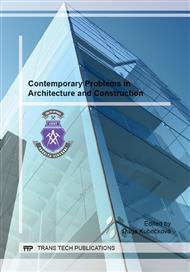p.865
p.870
p.875
p.879
p.883
p.888
p.895
p.900
p.904
Design of Mechanized Concrete Processes
Abstract:
The objective of any construction work is defined as the optimal use of resources, it is focused on building efficiency, so as to ensure quality in reaching the minimum construction costs and ensure environmental protection, safety at work. The building production is affected by many factors. With some we can count, but we cannot predict some for certain in advance. The essential precondition for successful implementation of a construction is thorough and timely preparation of pre-production and production engineering (technology designing), which provides for the effective implementation of the works.
Info:
Periodical:
Pages:
888-892
Citation:
Online since:
October 2014
Authors:
Keywords:
Price:
Сopyright:
© 2014 Trans Tech Publications Ltd. All Rights Reserved
Share:
Citation:


